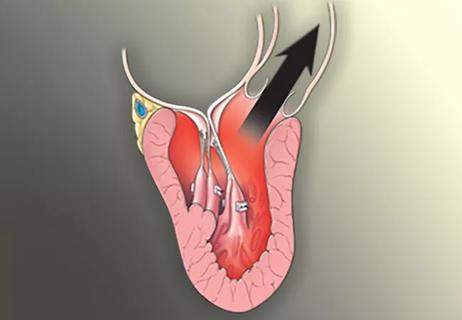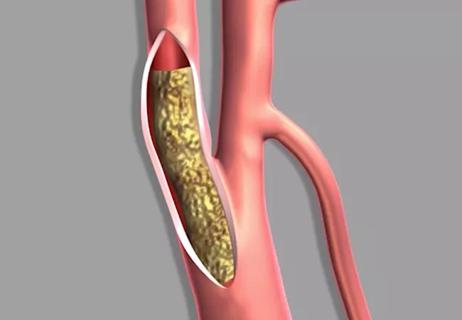Large cohort study finds high rates of high-grade atrioventricular block

Conduction system disease has been recognized as a common effect of transthyretin cardiac amyloidosis (ATTR-CA), but its incidence and significance in this setting have been insufficiently understood. Now a Cleveland Clinic study, published online in the American Journal of Cardiology in May, has added new insights into the incidence, prevalence and clinical impact of electrical failure in patients with ATTR-CA.
Advertisement
Cleveland Clinic is a non-profit academic medical center. Advertising on our site helps support our mission. We do not endorse non-Cleveland Clinic products or services. Policy
The single-center retrospective review of 369 consecutive patients with ATTR-CA found that a significant number suffered from conduction system abnormalities. At the time of diagnosis, about 10% had high-grade atrioventricular (AV) block requiring a pacemaker. Over a two-year follow-up period, an additional 11% developed AV block, and a further 7% went on to develop sinus node dysfunction. These patients had an increased risk of death within two years following their ATTR-CA diagnosis.
“If two in 10 patients with ATTR-CA need a pacemaker to support them following their diagnosis, all patients with ATTR-CA should be closely monitored during follow-up for the development of conduction system disease,” says the study’s senior and corresponding author, Wael Jaber, MD, a staff cardiologist in Cleveland Clinic’s Section of Cardiovascular Imaging.
Until recently, the diagnosis of ATTR-CA was made by biopsy and appeared to be rare. The advent of noninvasive testing with strain imaging echocardiography and technetium pyrophosphate scintigraphy (TcPYP) revealed ATTR-CA to be far more prevalent than previously recognized.
For instance, Dr. Jaber notes, whereas Cleveland Clinic diagnosed seven cases of cardiac amyloidosis using TcPYP in 2011, increased adoption of this noninvasive test led to over 400 TcPYP scans being conducted on Cleveland Clinic’s main campus alone in 2019, with 173 patients diagnosed with cardiac amyloidosis as a result.
Increased testing revealed frequent involvement of the conduction system, prompting a group of Cleveland Clinic cardiologists to undertake a retrospective study of consecutive patients diagnosed with ATTR-CA between January 2004 and January 2019 to better understand the incidence and prevalence of high-grade AV block requiring pacemaker implantation.
Advertisement
All patients had 12-lead ECG tracings, which were examined for evidence of conduction abnormalities at the time of diagnosis. Electronic medical records were reviewed for the implantation of cardiac devices.
At baseline, 9.5% of patients had been diagnosed with high-grade AV block requiring permanent pacemaker implantation. Over the 28-month follow-up period, high-grade AV block developed in an additional 10% of those with hereditary ATTR-CA and 12% of those with wild-type ATTR-CA.
“The most common conduction abnormalities seen at baseline were a wide QRS complex and first-degree AV block,” says Cleveland Clinic cardiovascular medicine fellow Eoin Donnellan, MD, first author on the study. “However, only a wide QRS complex was associated with the subsequent development of high-grade AV block.”
DNA sequencing was initially performed on the entire cohort to assess for the presence of a mutation in the TTRgene. The most common mutation was Val122Ile, which was found in 69% of patients. However, significantly more patients with the Thr60Ala mutation, which was present in 11%, had high-grade AV block at the time of diagnosis (see Figure below).

Figure. Top graphs show the prevalence of high-grade atrioventricular block at the time of diagnosis according to whether patients had hereditary (h) or wild-type (wt) transthyretin cardiac amyloidosis (left) and among those with the Val122Ile and Thr60Ala mutations (right). Bottom graphs show the incidence of high-grade atrioventricular block during follow-up according to the same breakdowns by amyloidosis type and mutation type. Reprinted from Donnellan et al., Am J Cardiol. 2020;128:140-146, with permission from Elsevier.
Advertisement
“Over the years, we have observed a higher rate of progression to AV block in patients with the Thr60Ala variant,” says Mazen Hanna, MD, a Cleveland Clinic cardiologist with subspecialty expertise in cardiac amyloidosis. “These patients should be considered for more aggressive monitoring for the need for pacemaker implantation. It remains to be seen whether the natural history of progressive conduction disease in these patients can be altered by the disease-modifying therapies that are now available.”
“Now that we know that patients with ATTR-CA have a high risk of AV block, ECGs are routinely performed at the first visit and every follow-up visit,” adds Dr. Jaber. “These patients are also at high risk for atrial fibrillation, and we recently showed (Europace. 2020;22[2]:259-264) that ablation for atrial fibrillation is most effective when performed earlier in the disease process. So we start monitoring patients immediately upon diagnosis, and we will use a Holter monitor or Zio patch if extensive monitoring is needed.”
Better understanding of how ATTR-CA can involve the heart’s electrical system opens the door for additive treatments, leading to improved outcomes.
“In a previous paper (J Cardiovasc Electrophysiol. 2019;30[11]:2427-2432), we demonstrated that early intervention with resynchronization in patients with ATTR-CA reduces heart failure and its associated mortality,” says Dr. Donnellan. “Now that we understand a significant percentage of patients also will experience conduction abnormalities, we can intervene with pacemaker implantation as well.”
Advertisement
He adds that the current study suggests AV block in ATTR-CA is likely the result of amyloid fibril infiltration into the conduction system. “If this is the case,” Dr. Donnellan concludes, “therapies that limit disease progression may reduce the need for pacemakers in this population.”
Advertisement
Advertisement

Blood test can identify patients who need more frequent monitoring or earlier surgery to prevent dissection or rupture

Study authors urge reevaluation of the sweetener’s safety designation by food regulators

Surprise findings argue for caution about testosterone use in men at risk for fracture

Findings support emphasis on markers of frailty related to, but not dependent on, age

Additional analyses of the two trials presented at 2023 ESC Congress

Prospective SPIRIT-HCM trial demonstrates broad gains over 12-month follow-up

Review of our recent experience shows it’s still a safe option

Machine learning may improve risk prediction and guide therapy